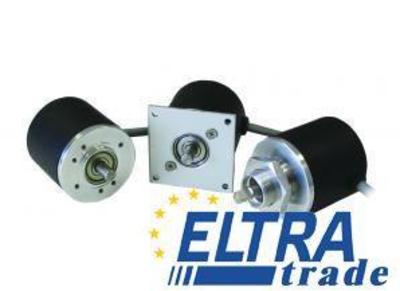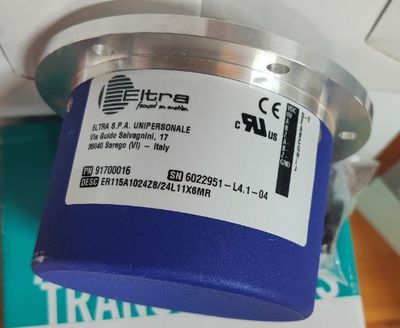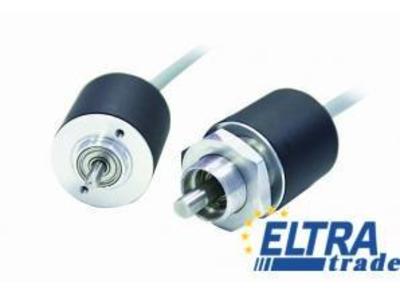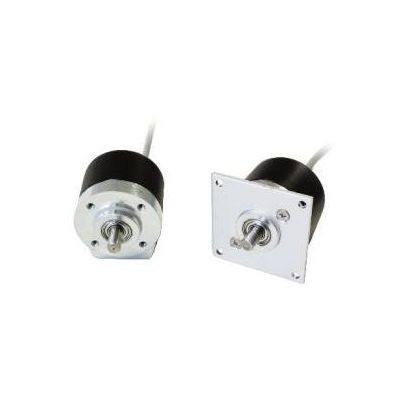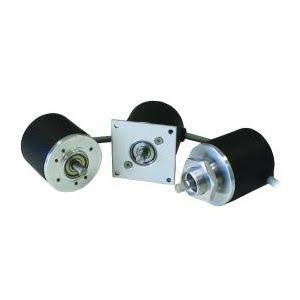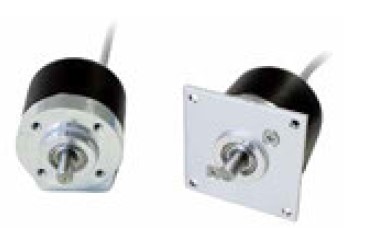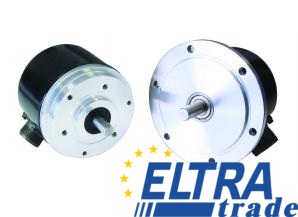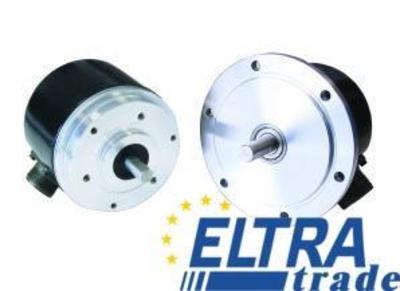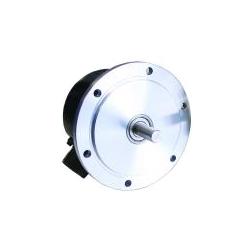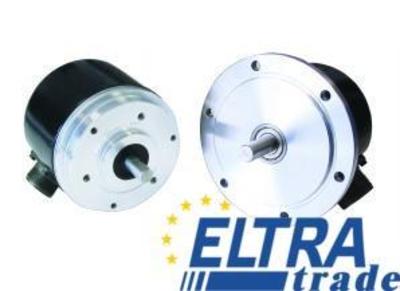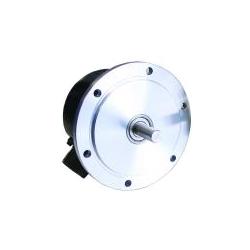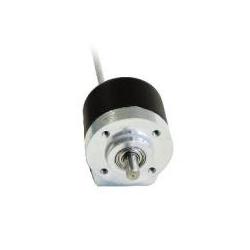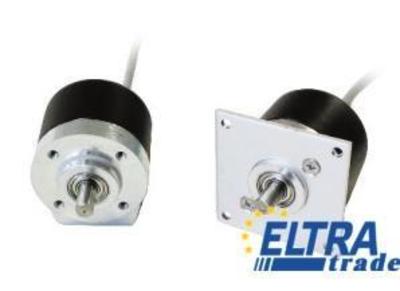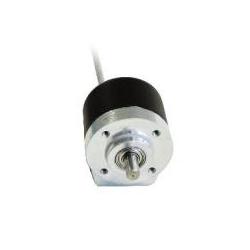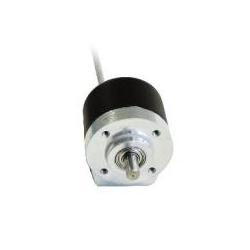Eltra Encoder Optical solid shaft encoder
Solid shaft incremental encoder optical fo general application. Miniaturized series with M21 threaded flange.
IN STOCK!!!
IN STOCK!!!
IN STOCK!!!
IN STOCK!!!
Incremental solid shaft encoder
- Resolution: 500 ppr
- Power suply: 8...24 DC V
- Max rotation speed: 3000 rpm
Incremental solid shaft encoder
- Resolution: 600 ppr
- Power suply: 5...28 DC V
- Encoder size 40 mm
IN STOCK!!!
IN STOCK!!!
EH115A1024/1024Z8/24L11X3PR.262
Incremental Encoder with solid shaft.
Incremental encoder
Optical Shaft Encoder
Incremental encoder
Solid shaft incremental encoder with REO-444 flange.
Incremental solid shaft encoder
Optical Shaft Encoder
Solid shaft incremental encoder. REO-444 flange with centrifugal relay.
Solid shaft incremental encoder. REO-444 flange with centrifugal relay.
Solid shaft incremental encoder. REO-444 flange with centrifugal relay.
incremental encoder with solid shaft and REO-444 flange.
Solid shaft incremental encoder. REO-444 flange with centrifugal relay.
Solid shaft incremental encoder. REO-444 flange with centrifugal relay.
Optical Shaft Encoder
Incremental solid shaft encoder
Optical Shaft Encoder
Incremental encoder
Incremental solid shaft encoder
Incremental encoder
Solid Shaft Encoders
Solid shaft encoders are position measurement devices that are used in various applications to convert mechanical motion into electrical signals. Unlike hollow shaft encoders, which are designed to be mounted directly on a motor shaft, solid shaft encoders have a solid, non-hollow shaft and typically require a coupling to connect them to the rotating shaft of the device they are monitoring. Let’s check more about incremental encoder with solid shaft.
Varieties of Optical Solid Shaft Encoders
There are different types of optical solid shaft encoders based on the technology they use for position detection. Here are a few common incremental solid shaft encoder types.
Incremental optical encoders
Incremental optical encoders generate a series of pulses as the shaft rotates. These pulses are then counted to determine the position and speed of the shaft. Incremental encoders do not provide absolute position information; instead, they propose changes in relative position. They usually have two output channels (A and B) that generate quadrature signals.
Absolute optical encoders
Absolute optical encoders provide a unique code for each rotation position. This means that even in the event of a power failure, the encoder can immediately provide an absolute position when power is restored. Absolute encoders are useful in applications where it is crucial to know the exact position without performing a homing procedure.
Gray code optical encoders
Gray code encoders use a binary code in which only one bit changes at a time as the shaft rotates. This helps reduce errors when reading a position since moving from one code to another is less prone to misinterpretation. Gray code is typically used in applications where position errors must be minimized.
Binary optical encoders
Binary optical encoders use a binary code to represent the position of the shaft. Each bit represents a specific position, and combining bits provides absolute position information. Binary encoders are simple in design and operation.
Multi-turn optical encoders
Multi-turn encoders provide shaft position information within one revolution and include additional revolutions or revolutions. This is especially useful in cases where the shaft makes several complete revolutions.
Single-turn optical encoders
Single-turn optical encoders provide position information per complete revolution of the shaft. They are suitable for applications where one revolution is sufficient for position feedback.
Miniature optical encoders
Miniature optical encoders are compact and designed for space-constrained applications. They support the same basic principles as larger optical encoders but are reduced in size.
Industrial Applications of Optical Solid Shaft Encoders
Solid shaft encoders are widely used in a variety of industrial applications where accurate and reliable position and speed feedback are critical. Here are some common applications of these industrial automation solutions.
Industrial robotics
Optical encoders are integral components of industrial robotic systems. They help robots determine their position and orientation, providing precise movement and control in manufacturing, assembly, and material handling processes.
Conveyor systems
Solid shaft optical encoders are used in conveyor systems to monitor the position and speed of conveyor belts. This is critical to maintaining proper material flow, detecting jams, and ensuring accurate product positioning.
Printing equipment
Printers and other printing equipment use optical encoders to control the position of print heads and paper feed mechanisms. This ensures accurate printing and image registration.
Packing equipment
Packaging equipment uses optical encoders to control the position and movement of packaging materials, enabling accurate and efficient packaging processes.
Textile equipment
In textile manufacturing, optical encoders are used in various machines such as spinning and weaving machines to control the position and speed of components for precision textile manufacturing.
Automated Guided Vehicles (AGV)
AGVs used in material handling and logistics use optical encoders to determine their position and navigate through warehouses or manufacturing facilities.
Medical equipment
Optical encoders play an important role in medical equipment such as diagnostic machines and robotic surgical systems, where precise positioning is critical for accurate diagnoses and procedures.
Paper and printing industry
Optical encoders are used in the paper and printing industries to control roller position and speed, providing precise control over paper handling and printing processes.
Automotive production
Optical encoders are used in a variety of automotive manufacturing processes such as robotic welding, assembly line operation, and quality control.
Advantages and Features of Eltra Optical Encoders
There are many features and advantages that incremental solid shaft optical encoders can show you. Here are some of them.
High resolution
Optical encoders can provide high-resolution output, precise position, and speed feedback. This is critical in applications where precise control and precision are required.
Contactless operation
Optical encoders operate without physical contact between the encoder components. The non-contact nature contributes to their durability and reduces wear and tear over time.
Reliability
Optical encoders are known for their reliability in providing accurate feedback over long periods. They are less susceptible to mechanical wear and have a long service life.
Fast response time
Optical encoders can provide fast feedback in real time, making them suitable for applications that require rapid adjustment or response to changes in position or speed.
Compact design
Optical encoders, including solid shaft models, often have a compact and space-saving design, making them suitable for applications with limited installation space.
High precision and accuracy
These devices provide high encoder accuracy, precise position, and speed measurements. This makes them ideal for applications where tight tolerances and accuracy are critical.
Versatility
Optical encoders can be used in various industrial applications across multiple industries, demonstrating their versatility. They can be adapted to different environments and operating conditions.
Incremental and absolute parameters
Optical encoders are available in both incremental and absolute configurations. Incremental encoders provide relative position changes, while absolute encoders provide precise positions within a revolution without the need to return to the original position.
Environmental sustainability
Optical encoders can resist environmental factors such as dust, moisture, and temperature fluctuations depending on their design and specifications. This is important for maintaining productivity in challenging industrial environments.
Selecting the Right Optical Solid Shaft Encoder
Selecting the appropriate incremental solid shaft encoder optical for a specific application involves considering various factors to ensure compatibility and optimal performance. Here are the key points when choosing one.
- Decide whether you need an incremental or absolute encoder. Incremental encoders provide relative position changes, while absolute encoders determine precise positions within a revolution without needing a reference point.
- Determine the required resolution based on the accuracy needed for your application. Higher resolution encoders provide more precise position and speed control.
- Consider the operating environment. Some encoders are designed to withstand harsh conditions, such as extreme temperatures, humidity, or exposure to contaminants. Make sure the encoder you choose meets the environmental requirements of your application.
- Check the mechanical compatibility of the encoder with your equipment. Check shaft size and mounting options to ensure proper fit. Some encoders may require special couplings or adapters.
- Choose between solid and hollow shaft encoders. Solid shaft encoders are mounted directly on the shaft of the rotating equipment, while hollow shaft encoders are mounted around the shaft.
- Consider the type of output signals required for your control system. Standard output signals include quadrature (A and B channels), index, and sometimes additional signals such as additional channels.
- Determine the maximum speed at which the encoder will operate. Some applications may require high-speed encoders, and exceeding the maximum speed may result in inaccuracies.
- Check the encoder power requirements. Ensure compatibility with your existing power system to prevent power supply problems.
- If the encoder is part of a more extensive control system, ensure it is compatible with the communication protocol used in your installation. Depending on the application, standard protocols include RS-422, RS-485, or others.
- Evaluate the encoder's resistance to vibration and shock, especially in applications where equipment is subject to frequent starts, stops, or shocks.
Technical characteristics of Incremental Shaft Encoder Eltra you can fine HERE (pfd)
